Embrace the joy of miniature gardening with our comprehensive list of the best terrarium plants. From low-maintenance plants that demand little of your time to exotic variants that transform your terrarium into a lush paradise, we’ve got you covered.
Ideal for both seasoned gardeners and those dipping their toes in the fascinating world of terrariums, our list of best plants for your terrarium guarantees a rewarding indoor gardening experience. Start building your own tiny, thriving ecosystem right in the comfort of your home or office!
1. Baby Tears (Pilea depressa)

Baby Tears almost resembles a clover on a vine and is a great choice for ground cover in terrariums.
©Skyprayer2005/Shutterstock.com
Pilea depressa ‘Baby Tears’ is a charming little climber that is sure to attract many plant lovers. Don’t mistake this for the well-known baby tears plant (Soleirolia soleirolii). This small vine boasts a thick carpet of vivid green leaves with gentle, often wavy edges.
While it appears delicate, it is actually quite resilient. This tiny plant is an easy pick for both terrariums and home gardens due to its small size and minimal care needs. Originally from Mexico, this tropical gem proves its adaptability.
It resembles a three-leaf clover on a trailing vine, bringing a lot of texture to its small size, making it a stellar choice for ground cover in terrariums.
Pilea depressa thrives under different light conditions, but it loves areas with plenty of bright, indirect light for optimal growth. Furthermore, it requires a regular and consistent water supply to stay healthy.
The ideal substrate for this plant should be able to retain ample water while also providing enough drainage to prevent root rot. This tropical beauty is comfortable in temperatures between 55 to 80 degrees Fahrenheit, but it does appreciate high humidity.
Pruning this plant is easy if it becomes too lengthy or dense for your preference. Feel free to trim as needed.
2. Venus Flytrap (Dionaea muscipula)

An excellent plant choice for a terrarium is none other than the Venus flytrap, but beware, as this plant is difficult to care for.
©sawinimages/Shutterstock.com
The Venus flytrap is a fascinating choice for a terrarium, but it’s not a beginner’s plant due to its specific care needs. It’s a well-known perennial species, blossoming every couple of years with white flowers adorned with green veins. Each trap has a limited number of uses before it withers and detaches.
Caring for a Venus flytrap involves meeting precise requirements for light, temperature, humidity, water, and soil. The ideal soil is a blend of peat moss and sand, and the plant prefers moderate to intense direct light.
To establish a warm environment, consider a heating pad beneath the terrarium, aiming for a temperature between 68 to 78 degrees F. Keep in mind that temperature preferences may vary based on the specific type of carnivorous plant. However, in the wintertime, your Venus flytrap will need to rest. Move it to an area that is much colder, around 32 to 50 degrees Fahrenheit. During this period, less light would be preferable as well.
Watering should be done with purified, distilled, demineralized water or natural rainwater. Feeding your plant is only necessary if it’s kept indoors, where it might not be able to catch its insect prey.
Terrariums can provide an ideal environment for these carnivorous plants with their high humidity, stable temperatures, and suitable lighting. But with that said, Venus flytrap terrariums are not for your beginner gardeners!
Carnivorous plants can grow in open or closed terrariums, but feeding may be challenging in closed environments due to limited access to insects. Either choose a container with a small opening or feed your plants manually.
3. Spider Plant (Chlorophytum comosum)
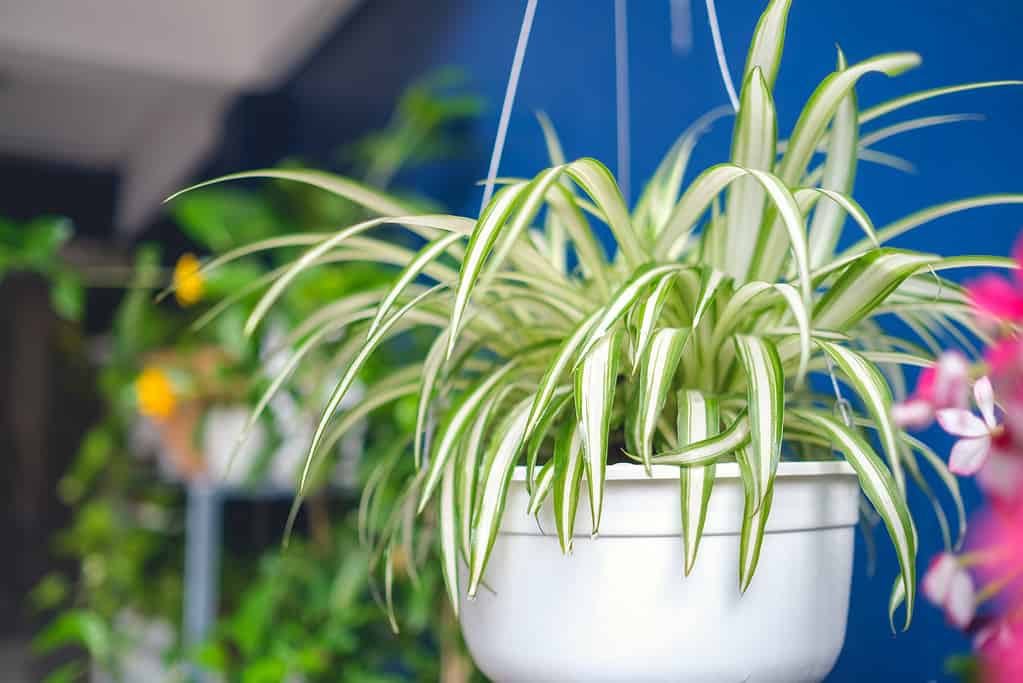
Thanks to its love of high humidity, spider plants are a great choice for terrariums.
©yaoinlove/ via Getty Images
Spider plants, with their elongated, green, and white striped leaves, bring a dash of dazzle to your terrarium. This plant is great for terrariums, as it loves high humidity and is perfect for those new to terrarium planting.
To set your spider plant just right, you need to consider the terrarium’s size, light, and airflow. In a compact terrarium, find a spot for your spider plant where it can get ample light and air. For larger terrariums, you could place them in the center, surrounded by other plants.
Set your spider plant in the terrarium, tucking its roots under the soil. Firmly but gently, press the soil around the plant base to aid root establishment. Ensure you leave space around the roots to facilitate growth.
Watering your spider plant appropriately is key. Water it when the top layer of soil feels dry. This might be around every two weeks, though it depends on your terrarium’s humidity level and temperature, of course. Always use lukewarm water to avoid root shock.
Ideal conditions for your spider plant are temperatures between 70 to 90 degrees F and humidity levels around 40 to 80%.
Watch out for tiny plantlets your spider plant might produce. Remove them promptly from the terrarium before they overrun it.
4. Sky Plant (Tillandsia Ionantha)
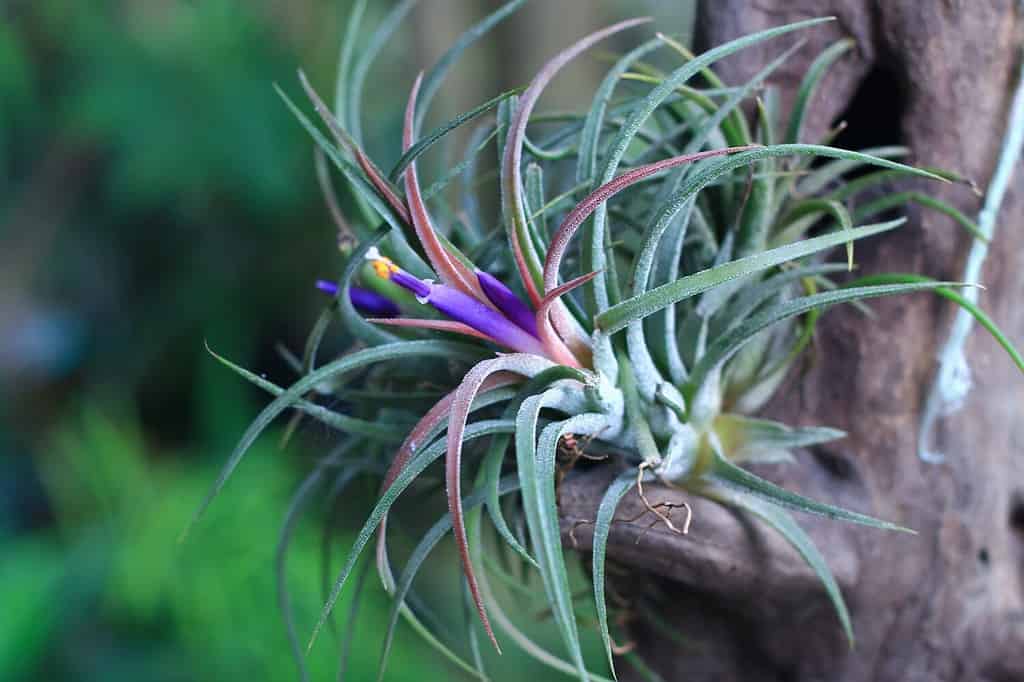
Sky plant is a type of air plant that is perfect for terrariums as it prefers high temperatures and humidity.
©Angkana6395/Shutterstock.com
Tillandsia ionantha, a type of air plant, is a widely favored choice for terrariums, prized for its resilience and its vivid foliage that bursts into red, violet, and pink hues when in bloom, earning it the nickname “Blushing Bride Air Plant.” Its leaves fan out evenly, creating an attractive, undulating tuft.
Belonging to the Tillandsia genus, the sky plant prefers tropical conditions with high temperatures and humidity. Ideally, keep the temperature between 60 and 80 degrees Fahrenheit during the spring to fall months. However, in the winter, it’s best to allow the temperatures to drop to around 50 degrees in order to encourage blooming the following year.
Good air circulation is important too! But with that said, while all air plants thrive in open terrariums and larger containers that offer ample airflow, this species can also adapt to a closed environment with proper care.
Tillandsia ionantha prefers bright, indirect sunlight. It can handle brief stints of direct sunlight, but too much could damage and dry out the leaves. Interestingly, the more humid your terrarium, the more the plant can withstand the dehydrating effects of direct sunlight. Alternatively, you can provide your sky plant with artificial light.
Unlike other air plants that require regular soaking, the sky plant only needs a little water to flourish. In an open terrarium, regular misting is essential (just two to three times a week), but in a closed terrarium, misting the surrounding plants may provide enough moisture indirectly. Remember: overwatering is the easiest way to harm air plants, such as your sky plant.
True to its name, the sky plant doesn’t need any substrate or soil to survive and thrives when mounted on branches or vivarium backdrops.
5. Boston Fern (Nephrolepis exaltata)
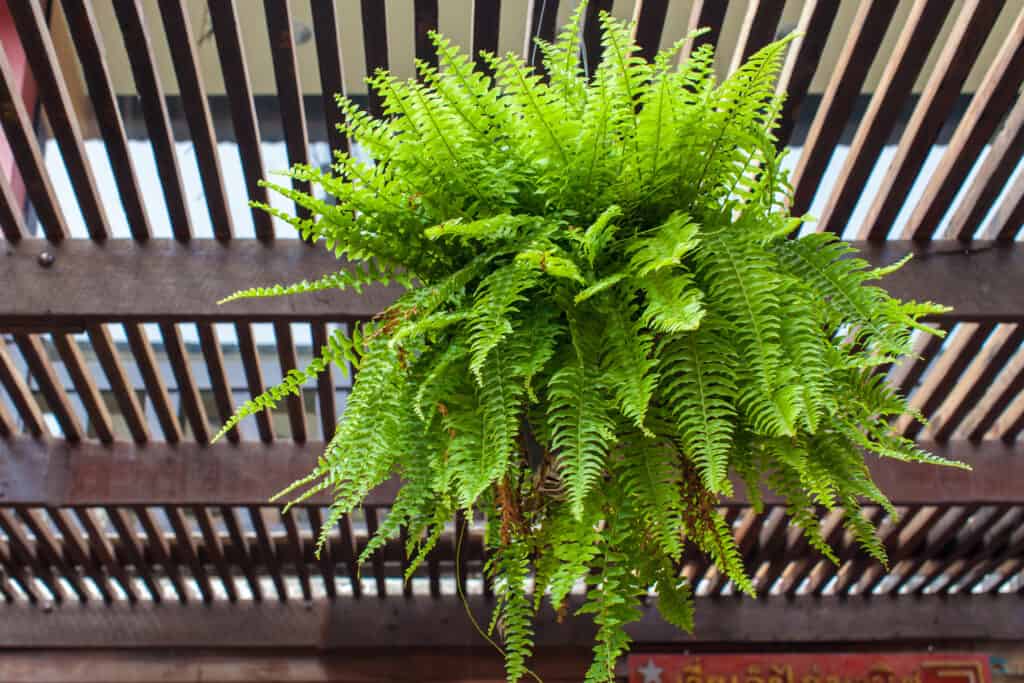
With its minimal care requirements, the Boston fern is one of the best plants to choose for your terrarium.
©Jeerayut Rianwed/Shutterstock.com
The Boston fern is a tropical sword fern from the Lomariopsidaceae family, which is a wonderful fit for a terrarium. This fern is renowned for its vibrant, lush green foliage, making it an attractive choice for beginners. What makes it stand out is its minimal care requirements and easy upkeep.
Boston ferns thrive in humid conditions and do well in temperatures ranging from 60 to 70 degrees Fahrenheit. They prefer bright, indirect sunlight but are also able to survive in lower light conditions. During the winter months, when home heating can cause dryness, it’s important to maintain adequate humidity for your plant.
To keep the humidity levels up, consider misting your Boston fern regularly or using a humidifier. Keep the soil consistently damp but avoid waterlogging, and don’t forget to fertilize the fern regularly for best results!
When choosing a Boston fern, opt for one with a healthy appearance and bright green leaves. Steer clear of ferns with brown or yellow leaves, which could indicate illness or general poor health. Once you’ve selected a healthy plant, transplant it into a well-drained potting mix within your terrarium.
With the right attention and care, Boston ferns can become beautiful, low-maintenance centerpieces in your terrarium!
6. Creeping Fig (Ficus pumila)
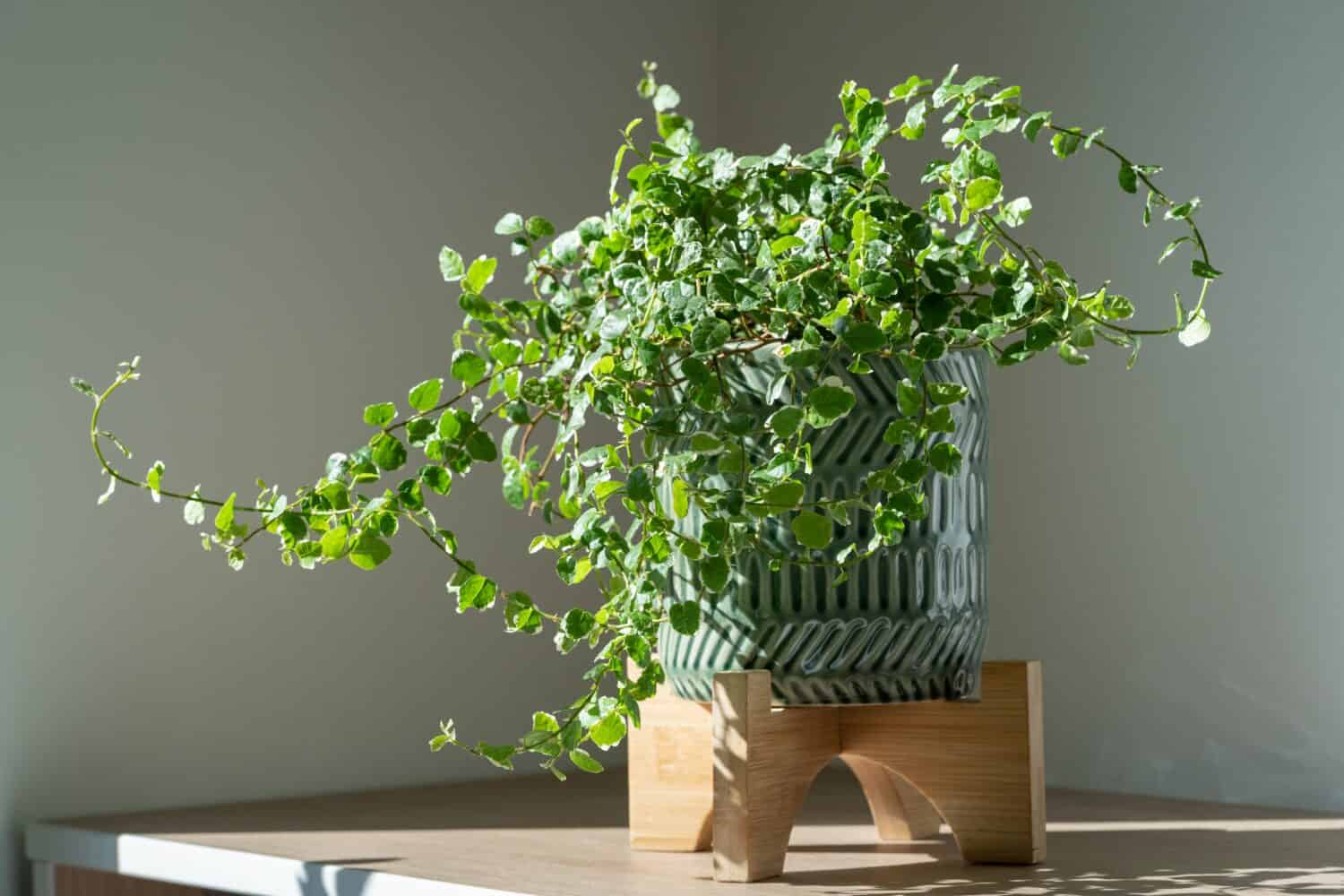
A charming vine, creeping fig loves warm and humid environments, making them perfect for terrariums.
©DimaBerlin/Shutterstock.com
Creeping fig, with its vibrant green heart-shaped leaves, is a charming little vine that can add life to any naturalistic setting. Its compact size, easy maintenance, and quick growth make it an increasingly popular addition to terrariums.
Hailing from East Asia, it’s perfectly adapted to the warmth and humidity of terrarium environments, promising a resilient choice for your terrarium project. Its vigorous growth ensures it quickly claims center stage.
Though the creeping fig appreciates bright, indirect light, it’s adaptable to a range of lighting conditions. While it may become slightly elongated in low light, it’s not a cause for concern. Even direct sunlight, typically avoided by tropical species, can work, resulting in compact growth. But with that said, in some cases, direct sunlight can lead to the leaves turning yellow or burning, so it’s best to stay away from direct sunlight if you can! Especially if you have other plants in your terrarium, most terrarium plants don’t do well with direct sunlight anyway.
This vine likes consistently moist conditions but is fairly robust and hardy. It can handle periods of dryness and isn’t too fussy about its climbing surface; it doesn’t require nutrient-rich surfaces to flourish. When planted on the terrarium floor, it appreciates a mix that provides good water retention and drainage.
It can cope with humidity as low as 60%, but higher (up to 90%) is better. Hence, a closed terrarium is its preferred habitat.
A word of caution: if planted on the terrarium floor, beware of overly wet soil, as creeping figs can be prone to root rot. To avoid this, a drainage layer can help provide security if you accidentally spray or mist too much.
7. Polka Dot Plant (Hypoestes phyllostachya)

Polka dot plants prefer bright, indirect light, much like other terrarium plants.
©aniana/Shutterstock.com
With their vivid speckled leaves, polka dot plants add a touch of fun and color to any terrarium. They are petite shrubs from the Hypoestes genus, native to Madagascar, but have gained worldwide popularity as houseplants all over the world, thanks to their unique and beautiful look. They’re available in a range of colors and varieties as well.
Bright, indirect light is best for the polka dot plant, but this plant is adaptable to various other lighting conditions. Though it can survive in low light, such conditions may reduce the vibrancy of its foliage. The plant also tends to stretch towards the light, causing irregular growth.
The watering needs of polka dot plants are somewhat delicate. They like even moisture and can wilt quickly when the soil dries out, though a swift spray of water can revive them. A nutrient-rich substrate that balances water retention and drainage is best.
Despite being common houseplants, polka dot plants favor high humidity and warmth, making them a great choice for terrariums.
Keeping the growth of polka dot plants under control can be a challenge. Regular pruning helps maintain their size. Furthermore, it’s important to note that these plants often have a short lifespan — usually just a year or so after blooming.
8. Cushion Moss (Leucobryum glaucum)
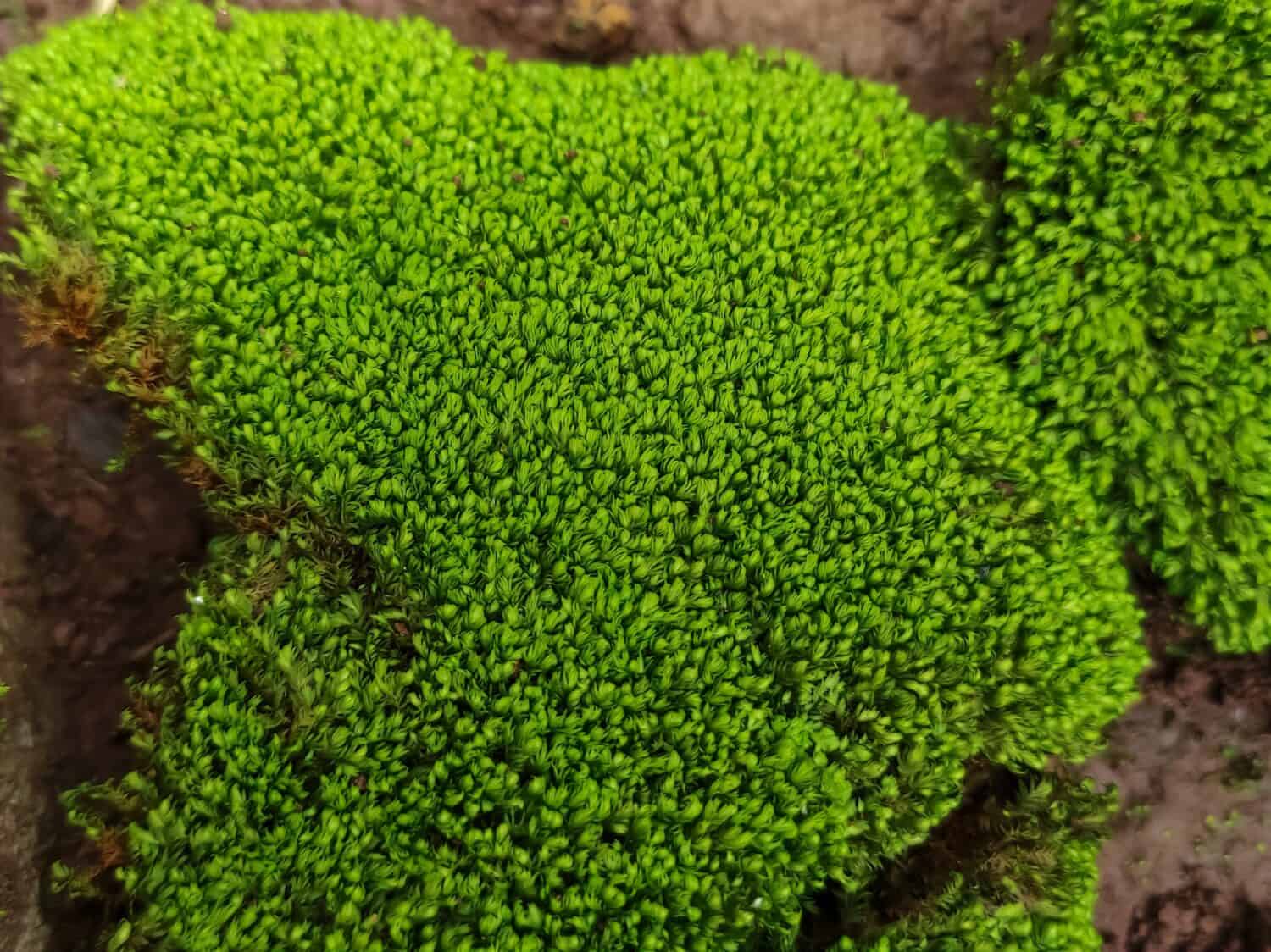
Making fantastic ground cover, cushion moss is a must-have in any terrarium.
©Noor Wahid/Shutterstock.com
Cushion moss, with its soft, green mounds, is a must-have element of a terrarium setup. Its vibrant texture lends an immediate touch of liveliness to any terrarium. This type of moss, commonly found in woodlands and wetlands worldwide, exhibits surprising adaptability, often outperforming tropical mosses in a tropical terrarium setting.
The growth pattern of cushion moss is quite compact, as it doesn’t branch out, creating dense clusters. This makes it an excellent choice for terrariums of varying sizes.
Though it can tolerate low-light conditions, cushion moss truly flourishes with a bit more sunlight. Therefore, optimal lighting would be bright but indirect. As with other mosses, it’s best to keep cushion moss away from direct sunlight, which is perfect since pretty much every terrarium plant prefers indirect light anyway! This plant can tolerate a tiny bit of direct sunlight, so don’t worry too much if it gets a couple of hours of direct sunlight every now and then.
Cushion moss prefers moisture-laden environments. It thrives when kept consistently damp but not waterlogged. Since this plant retains water really well, it’s very easy to overwater it, so always spray or mist, don’t pour!
It absorbs most of its moisture from the air and direct watering, so it adapts well to any terrarium substrate. The moss has tiny root-like structures called rhizoids, making it beneficial to lightly press it into the substrate for anchoring.
This moss enjoys a typical room temperature range between 65 and 80 degrees Fahrenheit. However, humidity is crucial, so a closed terrarium is a must. High humidity prevents the moss from drying out, ensuring it remains lush and vibrant.
9. Earth Star (Cryptanthus bivittatus)

Thriving in high humidity, earth star is one of the best plants for a terrarium.
©Andi WG/Shutterstock.com
The earth star plant is a captivating air plant that adds a distinct aesthetic appeal to your terrarium. Known for their star-shaped, striped leaves that bear a unique furry texture underneath, these plants are truly striking. They bloom small, pinkish-purple flowers from their base.
These plants naturally thrive in environments with temperatures between 70 and 80 degrees Fahrenheit and high humidity, often found nestled on forest floors or around rocks and logs. Striving to emulate their native conditions can simplify their care routine significantly.
For optimal growth, plant your earth star in soil that facilitates adequate drainage, such as a mix of sandy terrarium soil, orchid bark, and peat moss. Ensure proper drainage to prevent the roots from rotting and avoid overwatering, as these plants are particularly prone to such issues.
Bright, indirect sunlight is ideal for the earth star plant. A spot near a window or under LED terrarium lights that mimic natural sunlight will work perfectly. However, be careful to keep them out of direct sunlight to avoid leaf damage.
Maintain a humidity level of around 80% and water only when the soil feels dry to avoid root rot or fungal infections.
10. Golden Pothos (Epipremnum aureum)
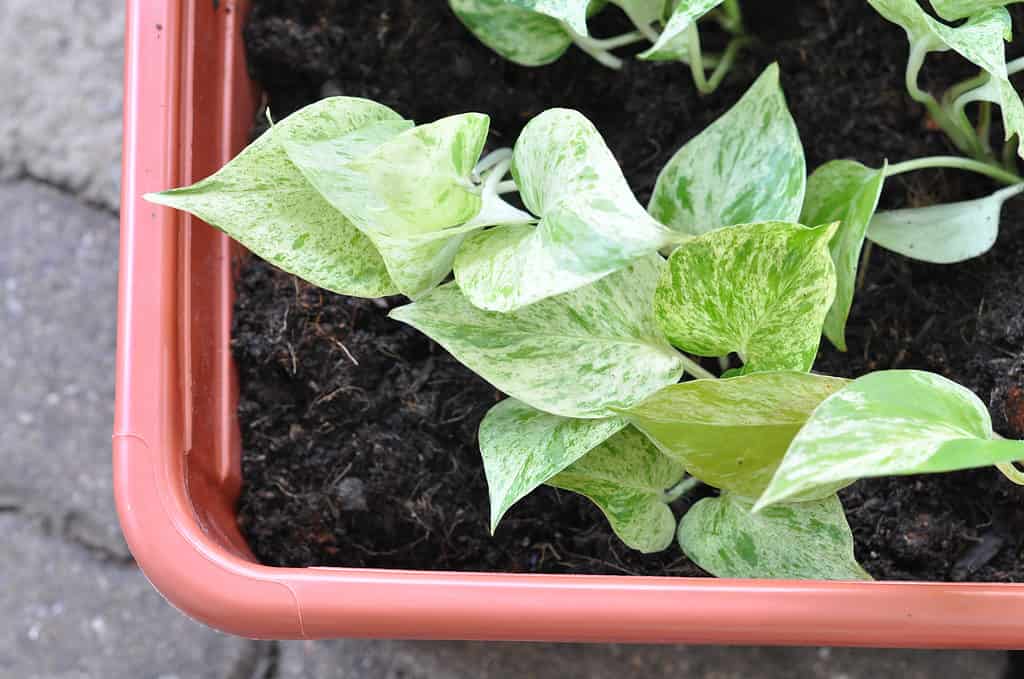
Although golden pothos can grow in both open and closed terrariums, it has a preference for closed terrariums.
©C_banglieng/Shutterstock.com
The golden pothos is indeed a star performer among indoor plants. Recognizable by its deep green leaves adorned with stunning yellow patterns, it’s an aesthetically pleasing terrarium plant. Native to French Polynesia, the golden pothos has made its way around the world. Although considered invasive in certain regions, this robust growth makes it an excellent choice for a terrarium.
Thriving in both closed and open terrariums (with a preference for closed), the golden pothos simply requires bright indirect sunlight and consistent moisture for optimal growth. This plant can also tolerate some low light and direct sunlight, though they aren’t ideal.
Humidity is particularly beneficial for this plant, making it an ideal terrarium resident. Aim for a humidity level of over 60%. The higher, the better. Lower humidity levels might result in leaf tips browning or crisping.
When it comes to watering, consistency is key. Maintain moderate watering and ensure the soil is regularly moist.
One crucial note: Golden pothos is toxic if ingested. Hence, if you share your space with curious pets or children, housing it inside a closed terrarium is a safe and secure option.
11. Nerve Plant (Fittonia albivenis)
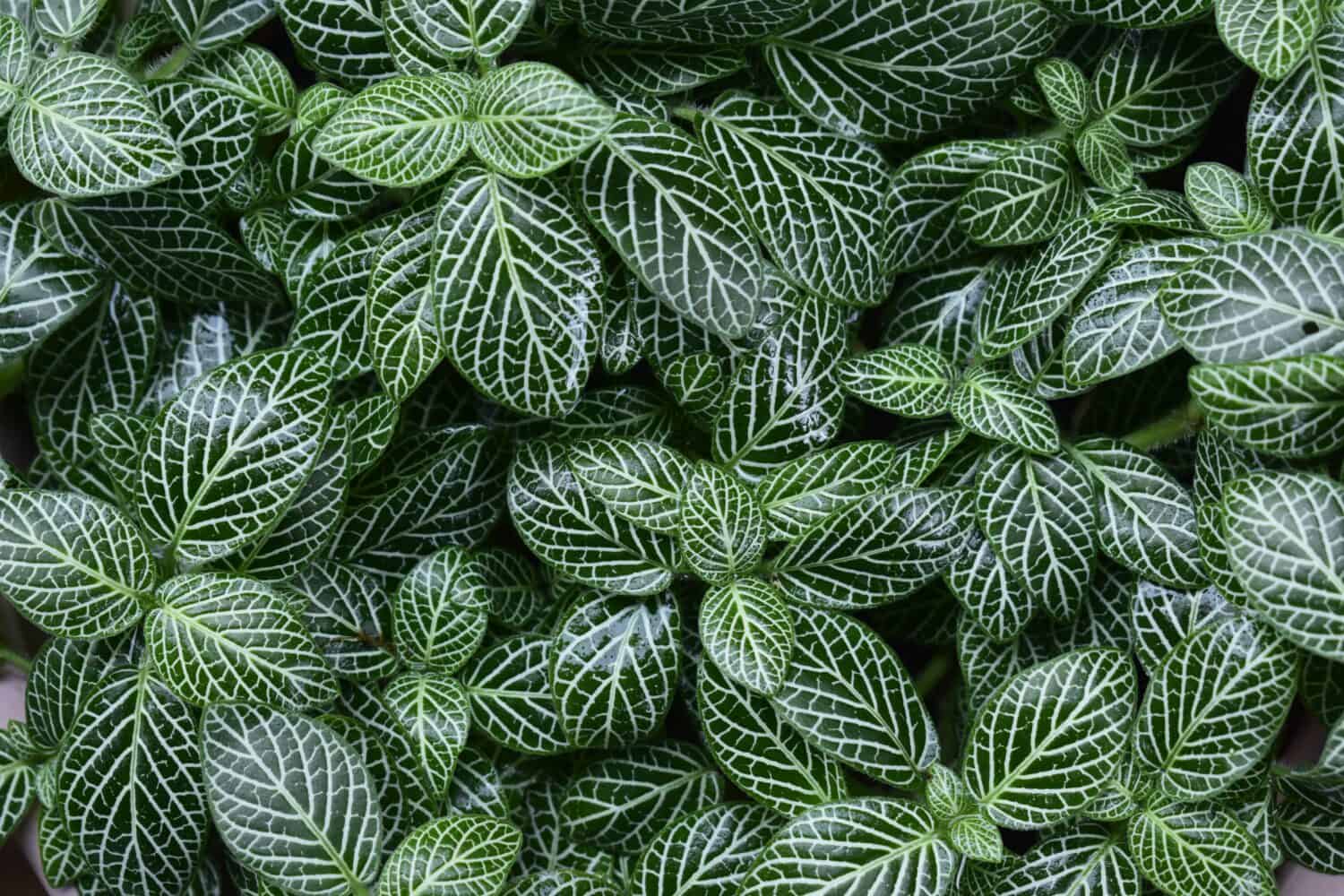
Nerve plants have eye-catching veins and require a high humidity level.
©Evade Mster/Shutterstock.com
Recognized for its eye-catching leaves adorned with vibrant red, white, or pink veins, the nerve plant, or Fittonia albivenis, is a popular choice for small terrariums. Originating from the tropics of Central and South America, it seldom flowers, but when it does, it produces delicate white blooms.
Thriving in a temperature range of 64 to 86 degrees Fahrenheit, this plant requires a high humidity level between 50 and 90%. Its compact size and love for warm, humid conditions make the nerve plant a perfect fit for terrarium environments.
For soil, a mix of 50% potting soil and 50% vermiculite or perlite offers the best organic-rich, well-draining environment. The plant favors a nitrogen-rich fertilizer for optimal growth.
The nerve plant enjoys bright, indirect light. Regular watering is key, but it’s essential not to overdo it. Keep the soil moist, not soggy. And finally, during the spring and summer, a water-soluble fertilizer every fortnight is recommended.
Summary of the Best Plants for Your Terrarium
| Plant | Botanical Name | Type of Terrarium |
|---|---|---|
| Baby Tear | Pilea depressa | Open |
| Venus Flytrap | Dionaea muscipula | Open and Closed |
| Spider Plant | Chlorophytum comosum | Closed |
| Sky Plant | Tillandsia Ionantha | Open and Closed |
| Boston Fern | Nephrolepis exaltata | Closed |
| Creeping Fig | Ficus pumila | Closed |
| Polka Dot Plant | Hypoestes phyllostachya | Closed |
| Cushion Moss | Leucobryum glaucum | Closed |
| Earth Star | Cryptanthus bivittatus | Closed |
| Golden Pothos | Epipremnum aureum | Closed |
| Nerve Plant | Fittonia albivenis | Closed |
The photo featured at the top of this post is © Evade Mster/Shutterstock.com
Thank you for reading! Have some feedback for us? Contact the AZ Animals editorial team.







